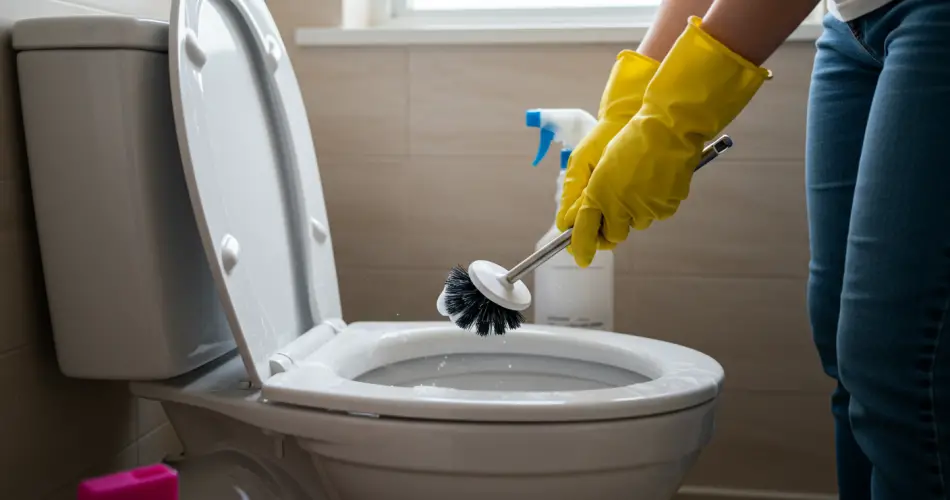Keeping a bathroom clean and hygienic is a priority for every household. However, even with regular cleaning, some problems persist—most notably the formation of limescale on toilets, sinks, and other bathroom fixtures. Limescale appears as unsightly yellowish deposits along the bowl, rim, or other surfaces, often forming despite daily cleaning routines.
Contrary to what many might believe, limescale is not caused by a lack of hygiene. It is primarily a result of hard water, which contains high levels of minerals such as calcium and magnesium. Every time water is flushed through the toilet or runs through pipes, these minerals can accumulate over time, leaving behind stubborn deposits. Besides being visually unappealing, limescale can also create unpleasant odors in your bathroom if left untreated.
In this article, we will guide you through a simple, effective, and completely natural solution to remove limescale from your toilet and bathroom surfaces. This DIY method is cost-effective, safe, and uses ingredients that you likely already have at home.
Why Limescale Forms in the Bathroom
Limescale thrives in areas where water evaporates slowly, leaving mineral residues behind. Toilets, sinks, and taps are particularly prone to this problem because water frequently contacts their surfaces and then evaporates. The issue can be worsened in homes with hard water, a common occurrence in many regions.
Bathrooms with persistent moisture or inadequate ventilation can also accelerate the formation of limescale. Even frequent cleaning may not prevent these deposits entirely, which is why a targeted solution is often necessary to dissolve and remove the mineral buildup effectively.
A Natural and Affordable Solution
Many commercial cleaners promise to remove limescale, but these products can be expensive and often contain harsh chemicals. For households seeking a cost-effective and eco-friendly alternative, a combination of natural ingredients can work wonders. This method not only removes limescale but also disinfects and deodorizes the bathroom.
The ingredients for this DIY limescale remover are simple:
-
White vinegar
-
Lemon juice
-
Baking soda
-
Powdered detergent
-
Water
These common household items are all you need to create a powerful, natural cleaning solution.
How to Prepare Your DIY Limescale Spray
Follow these steps carefully to prepare a highly effective limescale remover for your toilet and bathroom surfaces:
-
Mix the Ingredients – In a container, combine two teaspoons of white vinegar with a generous amount of freshly squeezed lemon juice. The acidity in both vinegar and lemon helps dissolve the mineral deposits.
-
Add Detergent – Stir in two heaping teaspoons of powdered detergent. This will help break down any dirt or grease that may be mixed with the limescale.
-
Incorporate Baking Soda – Add one teaspoon of baking soda to the mixture. This ingredient not only enhances cleaning power but also acts as a gentle abrasive to help scrub stubborn areas.
-
Dilute with Water – Pour 100 milliliters of clean water into the mixture. Mix thoroughly until all ingredients are well combined.
Once your solution is ready, use a funnel to transfer it into a spray bottle, which makes it easy to apply directly to the areas affected by limescale.
How to Apply the Solution
To maximize the effectiveness of this natural cleaner:
-
Spray the Solution – Thoroughly spray the mixture onto all surfaces of the toilet, paying special attention to the rim, bowl, and any visible limescale deposits.
-
Let it Sit – Allow the solution to sit for at least 10–15 minutes. This waiting period gives the acids in vinegar and lemon juice time to dissolve the mineral buildup.
-
Scrub the Surfaces – Use a sponge or toilet brush to scrub all treated areas. The baking soda in the mixture will help loosen even the most stubborn deposits, while the detergent ensures a thorough clean.
-
Rinse Thoroughly – Flush the toilet or rinse sinks and other fixtures with water to remove any residue, leaving surfaces clean, shiny, and free of limescale.
Benefits of This Natural Approach
Using a natural, homemade limescale remover offers several advantages:
-
Cost-Effective – No need for expensive chemical cleaners; common household ingredients are sufficient.
-
Eco-Friendly – Vinegar, lemon, and baking soda are biodegradable and safe for the environment.
-
Safe for Surfaces – Unlike harsh chemical cleaners, this solution will not damage porcelain, ceramic, or metal fixtures.
-
Deodorizes – Lemon and vinegar leave the bathroom smelling fresh and clean.
-
Easy to Use – The spray bottle application makes it convenient to target problem areas precisely.
Tips for Maintaining a Limescale-Free Bathroom
To prevent limescale from forming again, consider these simple habits:
-
Clean Weekly – Regular cleaning with this natural solution will keep deposits from building up.
-
Ventilate Properly – Ensure good airflow in your bathroom to reduce moisture, a key factor in limescale formation.
-
Flush Regularly – Avoid letting water sit stagnant in toilets or sinks for extended periods.
By incorporating these small habits alongside your weekly natural cleaning routine, you can enjoy a sparkling, hygienic, and limescale-free bathroom all year round.
Conclusion
Limescale is a common household challenge, especially in areas with hard water, but it doesn’t have to be expensive or complicated to remove. By using white vinegar, lemon juice, baking soda, and powdered detergent, you can create a powerful, natural cleaning spray that removes mineral deposits, disinfects, and freshens your bathroom.
With regular use, this homemade solution ensures your toilet and other bathroom fixtures stay clean, odor-free, and visually appealing, proving that effective cleaning doesn’t require harsh chemicals or costly products.
So the next time you notice yellowish deposits on your toilet or sink, reach for this simple natural solution—your bathroom will thank you!



